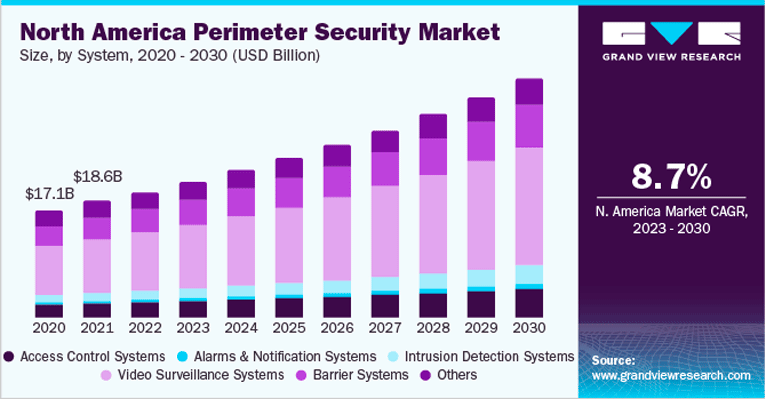Perimeter Security Market Set to be Worth Over $130 billion


Victoria Rees
Share this content
A new report has predicted that the global perimeter security market size will reach $132.4 billion by 2030, registering a compound annual growth rate (CAGR) of 9.4% from 2023 to 2030.
As outlined by Grand View Research, Inc., increasing insecurities among civilians and rising illegal activities, such as planned crimes, thefts, smuggling and human trafficking, have led to a rise in the adoption of perimeter security systems.
Additionally, technological proliferation has led to the growth of smart cities and smart infrastructure.
Owing to this, the implementation of systems including perimeter and physical security at commercial complexes, entertainment hubs and public sites is also on the rise.
Furthermore, the integration of security systems with the internet and the latest mobile devices has made surveillance easier.
The latest technology has also led to the introduction of infrared, microwave, radar and seismic sensors.
The report also says that the system integration and consulting services segment dominated the market in 2022 and is estimated to generate high revenue by 2030.
Article Chapters
ToggleWhy Has Perimeter Security Market Demand Increased?

The demand for perimeter security systems arises in the energy sector for securing power plants and protecting them against external threats and technology misuse, especially in nuclear power plants.
In an attempt to enhance security, organizations install internet-based and automated security systems.
Increasing concerns regarding public security and safety, growing demand for spy cameras and rising adoption of IP cameras are driving the video surveillance systems segment within the perimeter security market.
The report highlights that the video surveillance systems segment is expected to register the fastest CAGR over the forecast period due to the large-scale investments in smart infrastructure projects by various nations.
The global community need to improve safety and security across many industries is contributing considerably towards market growth.
However, alarms and notification systems within perimeter security are expected to grow at a slow pace in the market over the forecast period.
The growth in terrorist threat and cross-border intrusions has forced governments to enact strict regulations regarding national safety, leading to market expansion.
The fast-paced development of smart cities and smart infrastructure in the US and Europe is one of the key factors driving the market.
Governments increasingly favor installing various security systems in strategic sites.
Technological development related to automation has accelerated the adoption of the latest methods, such as video analytics and aerial drones, to produce better results.
Some of the key players in this market listed by the report include Axis Communications AB, Barrier1 Systems, Inc., Honeywell International, Inc., Puretech Systems and Senstar Corporation.
Perimeter Security Market Report Highlights

In 2022, the market was dominated by the system integration & consulting services segment, projected to continue generating substantial revenue until 2030.
System integration & consulting services play a pivotal role in enabling businesses to seize opportunities for heightened performance and rapid innovation.
This dynamic drives growth potential within this segment.
The energy sector requires perimeter security systems to safeguard power plants against external threats and technological misuse.
This need is particularly pronounced in nuclear power plants.
Organizations are increasingly adopting internet-based and automated security systems to bolster security measures.
The video surveillance systems segment is experiencing growth due to heightened concerns about public security & safety, the escalating demand for spy cameras, and the widespread adoption of IP cameras.
The Asia Pacific region is anticipated to exhibit the fastest Compound Annual Growth Rate (CAGR) throughout the forecast period. This projection is attributed to the region’s burgeoning infrastructure developments.


